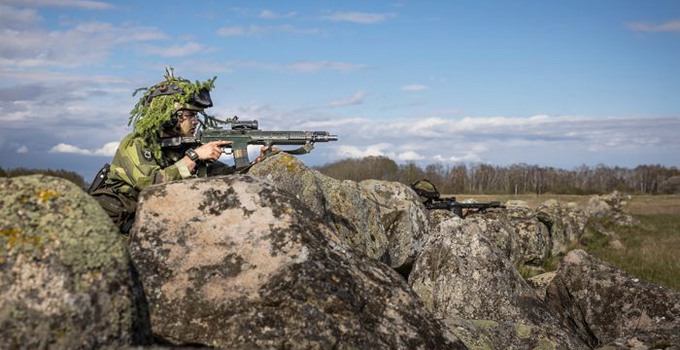
The person in the photo is not related to the article. Photo: Antonia Sehlstedt/Försvarsmakten.
"Some units experience significantly more accidental shots than others"
Every year, several accidental discharges occur within the Armed Forces, sometimes with a fatal outcome. By scanning the safety culture, some of these accidents could be prevented, according to Martin Schüler, who has investigated perceptions of weapon handling and safety at a regiment.
In the fall of 2022, a soldier at the Life Guards died after being hit by an accidental discharge. The subsequent investigation concluded that the safety culture had influenced the incident, and the description of the event showed that social factors had contributed.
Previously, accidental discharges were often explained by the individual who accidentally fired the shot making a mistake, according to Martin Schüler, who is a major, military teacher and PhD in work-integrated learning at the Swedish Defence University.
"There have been quite a few serious accidents and weapon incidents in the Armed Forces. Some have resulted in fatalities where soldiers died from accidental discharges. One can almost get the impression that the seriousness of weapon handling has been somewhat lost," says Martin Schüler.
This is the background for the pilot study he conducted, which has been published in the scientific journal Proceedings of the Human Factors and Ergonomics Society Annual Meeting.

Martin Schüler, major, military teacher and PhD in work-integrated learning at the Swedish Defence University.
Experience of accidents leads to silence
Martin Schüler wanted to see if it was possible to measure perceptions of weapon handling and safety, and how seriously employees in the Armed Forces take firearm training. He developed thirteen statements about the perception of handling firearms during training, which he tested on employees at a regiment. "In our work group, it's more important to handle the weapon quickly than safely," "we who work here accept that accidental discharges occur during training," and "in our unit, we do not talk about weapon-related mistakes" were some of the statements that respondents had to consider. 336 people responded.
He also asked whether, and if so, how many accidental discharges the respondent had observed at their workplace over the past twelve months. Not how many the respondent themselves had caused.
"I tried to direct it so that those who responded would assess their surroundings. This is a charged area, associated with shame and guilt. Quite a few responded that they had experienced accidental discharges," says Martin Schüler.
New factor "serious firearms training"
Subsequently, he used statistical methods to identify patterns in the responses. Half of the statements were dropped. Martin Schüler identified a new factor he calls "serious firearms training," which reflects how defense force personnel collectively perceive knowledge and learning about firearms.
This new factor could be used along with others to create a statistical model of the environment surrounding an accidental discharge. In the model, two overarching factors, safety voice and safety participation, could be distinguished. Safety voice involves raising and discussing safety issues at work, while safety participation concerns the employees' ability to create and perform their work safely.
Respondents with experience of accidental discharges scored lower on both factors.
"The experience of an accidental discharge seems to affect the ability or willingness to discuss safety-related aspects and participate in safety efforts at the workplace," says Martin Schüler.
A hypothesis is that the experience of accidental discharges has a negative effect on learning and increases stress, which in turn raises the risk of more accidents.
Cultural differences may impact
The unreported number of accidental discharges is assumed to be significant. It may be that failures at the shooting range are handled in a way that decreases the likelihood of reporting incidents, Martin Schüler believes. This leads to gaps in knowledge not being identified.
"It would be interesting to look at situations around shooting training and weapon handling and how personnel who accidentally shoot on the wrong range or discharge a weapon accidentally are managed," he suggests.
If accidental discharges were solely due to the lack of shooting skills of individuals, there wouldn't be a pattern in their occurrence, Schüler argues.
"Then everyone would have experienced about the same number. But there is a pattern here. Some units experience significantly more accidental discharges than others."
According to Martin Schüler, the results of the study could be used to scan regiments for units with poorer safety cultures and then direct preventative measures towards them. The results could also potentially influence the training of instructors and how instructors learn to manage shooters who make mistakes.
The results of the study need to be validated, and measurements need to be taken at more locations within the Armed Forces, he emphasizes. Then there is the question of what to do with the results after scanning, and what methods could be used to create change. Perhaps the issue is not with the weapons training per se, but with cultural differences that develop in various places.
"This affects a lot in individual cases. The training might not have quality issues itself, but it could be about how different unit cultures handle mistakes and accidents," says Martin Schüler.
Publication
Martin Schüler (2024): Firearm Safety Dimensions, an Extension of the Military Safety Climate Questionnaire., Proceedings of the Human Factors and Ergonomics Society Annual Meeting
More about
Page information
- By:
- External Relations and Communication Office - Freelance writer Emmeli Nilsson.
- Published:
- 2024-11-12
- Last updated:
- 2024-12-16
